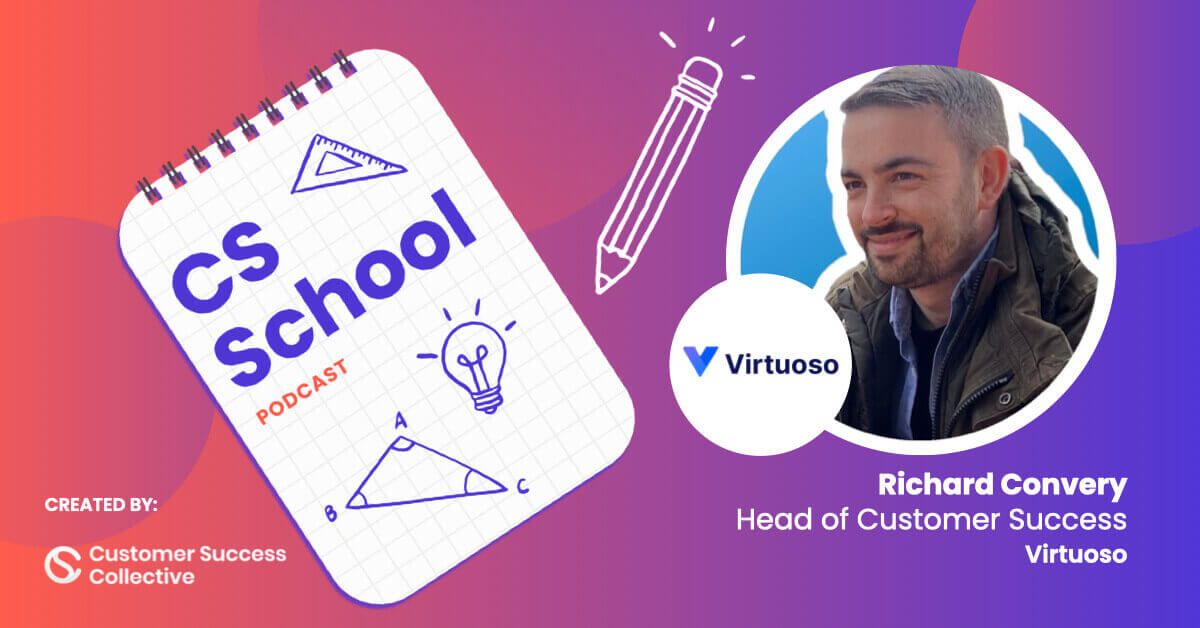This article is based on a keynote presentation Finlay gave at Customer Success Festival London 2022.
Catch up on this presentation, and others, using our OnDemand service. For more exclusive content, visit your membership dashboard.
As the VP, Commercial at Otta, a fast-growing job search platform, I've had the privilege of deeply understanding what candidates are looking for in their next role. You see, over the last 20 years, I've worked across startups, scaleups, and enterprises – and I've learned a thing or two about building effective, customer-centric teams.
In this article, I'm going to share my top insights on hiring and developing a world-class customer success team, including tips such as how to:
- Avoid the “Swiss army knife” trap in hiring
- Understand what candidates really want
- Realize the power of salary transparency
- Develop a data-driven, customer-centric mindset
- Cultivate loyalty through emotional connections
- Embrace continuous reinvention in your career
- Overcome formidable competition
Whether you're building out your customer success team for the first time or looking to take an existing one to new heights, these strategies and principles will help guide you on your journey.

Avoiding the "Swiss army knife" trap in hiring
One of the biggest challenges I see companies face is crafting job descriptions that actually attract the right candidates. Far too often, I come across overly broad, generic listings that try to find a "Swiss army knife" – someone with an impossibly encyclopedic list of skills and experience.
Instead, I really believe you need to focus on the essential mindset and values you're looking for, rather than just specific hard skills.
For example, I recently reviewed a customer success role on our platform that was essentially a grab-bag of responsibilities – from managing senior stakeholders to leading inbound sales to running operational processes. What you might as well have said is, "Actually, I'm looking for a Swiss army knife, please." This kind of catch-all approach is a surefire way to turn off top talent.
Rather than overwhelming candidates with endless requirements, think about the core competencies and traits that will enable someone to thrive in the role.
- Is it a customer-centric mindset?
- Strong problem-solving skills?
- The ability to think strategically while also executing tactically?
Identify those key ingredients and build your job description around them.
Understanding what candidates really want
When candidates sign up for Otta, the first thing we do is have them complete a detailed quiz to understand their unique preferences and priorities. Interestingly, the top factors they care about are not always what you might expect.
Over 56% of candidates rank flexibility and meaningful work as their top priorities, far outweighing things like compensation. In fact, salary is only selected by around 20% of people as a key consideration. As a customer success leader, you’re clearly a commercial person, you're interested in money as most teams are. But actually, you need to be asking yourself: “Are we showcasing what our flexible working policy is?”
Over 50% of candidates rank flexibility and meaningful work as their top priorities, far outweighing things like compensation. In fact, salary is only selected by around 20% of candidates as a key consideration.
This highlights an important point – while money is certainly important, today's top talent is increasingly seeking roles that offer a sense of purpose and control over their work-life balance. They want to feel that the work they're doing has a tangible, positive impact and that they have the autonomy to do it in a way that works best for them.
One of our customers, Hook, has done an excellent job of signaling this in their job postings. They have a very clear and transparent policy around what their "hybrid" work model actually entails – not just a vague bullet point, but specific details on how many days per week they expect employees to be in the office. This level of clarity is hugely appealing to candidates.

The power of salary transparency
Salary is a notoriously tricky and often contentious topic. However, I firmly believe that being upfront about salary ranges is one of the best ways to combat the gender pay gap.
When entry-level candidates sign up for Otta, men and women select the same starting salaries. But as careers progress, we see a troubling trend – women tend to select lower salaries than their male counterparts, with the gap widening to around 13% at the expert/senior level.
This suggests that the pay disparity is not simply a result of women choosing different career paths or negotiating less aggressively. Rather, it's a learned behavior that develops over time, likely due to societal biases and norms.
By proactively sharing salary information in job postings, you can help address this issue head-on. In fact, we've found that jobs that include both salary and diversity/inclusion details receive over 2x the number of applicants compared to those with neither.
Granted, being transparent about compensation isn't always easy, especially for smaller or earlier-stage companies. But I'd urge you to have those difficult conversations - not only is it the right thing to do, but it can provide a significant competitive advantage in attracting top talent.

Developing a data-driven, customer-centric mindset
Building a world-class customer success function is critical, but it requires a delicate balance of instinct and data-driven decision-making. Here are some of the key principles I follow:
Focus on understanding your customers
The foundation of great customer success is truly understanding your customers' businesses – their challenges, objectives, and competitive landscape. By uncovering unique insights, you can position yourself as a trusted partner, not just a vendor.
At Otta, we've found that the teams that are most successful in engaging customers are the ones who can demonstrate a deep knowledge of their clients' industries and the specific issues they're facing. It's not enough to just recite facts and figures – you need to show that you've taken the time to learn about their world and can offer tailored solutions.
One of the ways we do this is by actively encouraging our Customer Success Managers (CSM) to look beyond their immediate sector for inspiration. For example, we once hired a CSM who had previously been a professional poker player. His insights on the importance of process, commitment, and emotional intelligence have been invaluable in helping our team develop a more strategic, consultative approach.

Leverage data to challenge assumptions
Of course, instinct and experience are crucial, but I also believe in the power of data to challenge common assumptions and demonstrate the value you can provide.
As a platform business, we have access to a wealth of information on what's working (and what's not) when it comes to hiring and retention. We use this data to have more compelling, evidence-based conversations with our customers.
For instance, we recently shared research showing that jobs that include salary information receive 76% more applications on average than the bottom-performing companies on our platform. This helps us make a strong case for salary transparency, even when it may feel like a risky or uncomfortable conversation to have.
Similarly, we're able to dispel the myth that people don't actually apply for jobs unless they're explicitly headhunted. In reality, less than 5% of our candidates are "just looking" – the vast majority are actively engaged in the job search process. Arming your team with these kinds of insights can be a real game-changer.
Look outside your industry for inspiration
Some of the best ideas come from unexpected places. I encourage my team to seek inspiration from industries and disciplines beyond our own. For example, we've learned valuable lessons about process-driven execution and "flawless" customer experiences from studying the habits of top surgeons.
The story goes that a Disney executive, shortly after joining the company, decided to attend a Disney on Ice show incognito. As he waited in line, he noticed that the majority of moms and kids had homemade Disney-themed costumes. Intrigued, he asked them if they'd be interested in buying official Disney versions – and lo! and behold, that became a $6 billion business for the company.
The lesson here is that sometimes the best solutions are right in front of you if only you take the time to truly observe and understand your customers. By looking beyond your immediate industry, you open yourself up to new ways of thinking that could transform your approach to customer success.

Cultivating loyalty through emotional connections
While there is certainly a rational, logical component to customer loyalty, the emotional connection is often more powerful. Focusing on how you make customers feel, not just the functional benefits you provide, can be a real game-changer.
At Otta, we've found that our most loyal customers – both clients and candidates – are the ones who feel a deep sense of alignment with our mission and values. They love the way we approach diversity and inclusion, they appreciate our commitment to salary transparency, and they feel a genuine sense of partnership in our work together.
This emotional engagement is something that's difficult for competitors to replicate. It's not just about providing a better product or service, but about cultivating a relationship built on trust, empathy, and a shared sense of purpose.
One way we try to nurture this loyalty is by making a concerted effort to celebrate our customers' successes, even if they aren't directly related to our platform. We find that little gestures, like sending a congratulatory note or hosting a virtual event to highlight their achievements, go a long way in strengthening those emotional bonds.

Embracing continuous reinvention in your career
In an era of constant change, the ability to continuously reinvent yourself is crucial, both for your team and for your own personal and professional growth.
The modern workforce is characterized by increased job and industry fluidity. In fact, the average person entering the job market today will have 25 different roles across seven different sectors before retirement. That's a far cry from the days of my own father, who worked in the North Sea oil rigs for 18 years with the same routine of two weeks on, two weeks off.
This level of career dynamism can be daunting, but it also presents an incredible opportunity. Rather than seeing each job change or industry shift as a threat, view it as a chance to expand your skillset and reinvent yourself. What you learned 10 years ago may not be relevant for the next decade, so be prepared to continuously evolve.
One of the things I love most about working in the customer success field is the constant need to adapt and grow. We're not just supporting our customers - we're also supporting our own teams in navigating these changes. By modeling a mindset of lifelong learning and adaptability, we can inspire our customer success professionals to embrace the same mindset.

Overcoming formidable competition
It's easy to get bogged down by the actions of competitors, especially when they seem to have significant resources or market share. However, I encourage my team to focus on what they can directly influence and improve, rather than worrying about things outside of our control.
A great example of this is the story of Waze, the navigation app I helped build in the UK. Back in 2012, when Waze was still a relatively young and nascent company, there was widespread concern that the launch of Apple Maps would spell the end of our business. After all, Apple was a tech behemoth, and their mapping product was sure to dominate the market.
But what happened next was the opposite of what everyone expected. Apple Maps launched to widespread criticism, with users reporting all sorts of issues with the accuracy and functionality of the product. In a surprising move, Apple CEO, Tim Cook even went so far as to recommend that customers use "services like Waze" while they worked to improve their mapping solution.
This was a pivotal moment for Waze – our downloads spiked dramatically, and six months later, Google acquired the company for $1 billion. It just goes to show that even when you're facing formidable competition, focus on what you can control and your own unique value proposition.
The market will reward that authenticity and excellence.
Wrapping up
Building a top-notch customer success function requires a multifaceted approach that spans talent acquisition, team development, and customer-centric mindsets. By prioritizing flexibility, transparency, and continuous learning, you can position your organization for long-term success.
I hope these insights have given you some practical strategies and principles to apply within your own customer success teams.
Remember, the key is to stay adaptable, curious and focused on what truly matters to your customers. If you can do that, you'll be well on your way to hiring and developing the best possible customer success team.
Leadership can be learned. Let's begin.
If our exploration of customer success leadership has stirred a desire to take your expertise to the next level, we have the perfect opportunity.
Enroll in our Customer Success Leadership program and become a champion of driving customer success while propelling business growth.
What to expect from this game-changing course:
🧠 Continuous, actionable leadership insights from industry pioneers
🔧 Practical leadership strategies and tactics to implement
📚 Hands-on activities and real-world case studies
💡 An endless stream of fresh ideas and diverse perspectives
🔥 Transform your leadership style
🧱 Build a strong personal brand with guidance


